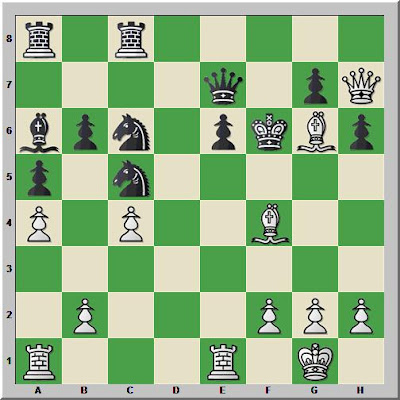Having failed twice, I sought the whole game and found it in Big Database 2011. I reviewed the opening, the middlegame maneuvers, and the finale. Briefly, I contemplated making the effort to memorize the game, but rejected that plan. Chess Informant published the concluding combination, but not the whole game. I recall CI's description of its selection criteria.
If a game was between two very top players then there should be a positive reason for rejecting it. On the other hand, games between lesser players require a positive reason to be included.The game fails to meet the standard for inclusion as a whole, and my criteria for choosing games to memorize must be far more selective than Informant's inclusion criteria. Even so, a larger portion of this game merits study than the finale published in Informant. The game is Della Morte -- Mayorga, Villa Martelli 2011. White is an IM and Black an FM. The CI combination begins with White's move 26 as played in the game. I present the position after Black's 18...Nb4 below.
Aleksandar Matanovic, "Seventy Volumes," Informant 71, 384
White to move
r4rk1/2q1bpp1/bp2pn1p/p3N3/PnP4Q/1B3N2/1P3PPP/R1B1R1K1 w - - 0 19
White created a threat.
19.Qg3
The immediate 19.Bxh6 was stronger.
19...Kh7
19...h5 was also possible, but White maintains an advantage.
20.Ng6! Rfc8 21.Nxe7?
White is letting the advantage slip away. 21.Qxc7 was the strongest move. 21...Rxc7 22.Bf4 Rb7 23.Nxe7 Rxe7 24.Rad1 with better piece coordination and mobility.
21...Qxe7
White to move
r1r5/4qppk/bp2pn1p/p7/PnP5/1B3NQ1/1P3PPP/R1B1R1K1 w - - 0 22
22.Ne5 Nd7 23.Bf4
White is creating tactical threats, but these can be parried with accurate defense. One idea might be to secure the f6 knight with a rook lift Rc8-c5-f5.
23...Nc5 24.Bd1
Black to move
r1r5/4qppk/bp2p2p/p1n1N3/PnP2B2/6Q1/1P3PPP/R2BR1K1 b - - 0 24
24...Nc6??
This blunder sets up White's tactical shot. The knight is well-placed on b5 because it restrains the light-squared bishop. Even so, it is not surprising that Black should wish to get rid of White's well-placed knight on e5. 24...Bb7 may have been Black's best move. White has the initiative, but no clear tactical shots.
25.Bc2+
25.Nxc6 is also good. 25...Rxc6 26.Bf3 winning the exchange.
25...Kh8?
25...Kg8 is better. After this second error, we have the position in the Informant combination.
26.Ng6!
With the bishops well-coordinated, the queen in a menacing position, and most of Black's pieces poorly placed for defense, this sacrifice should be easy to find.
26...fxg6 27.Qxg6 Kg8 28.Qh7+ Kf7 29.Bg6+ Kf6
White to move
r1r5/4q1pQ/bpn1pkBp/p1n5/P1P2B2/8/1P3PPP/R3R1K1 w - - 0 30
30.Bh5 is the wrong move, although it is winning. I played it twice this week during my training.
30.Bg3! Kg5
Black steps into a mating net, but the game still ends with an easy win for White after 30...e5.
31.f4+ Kg4 32.Re3 Rh8 33.h3#.
In this game, White maintained the initiative out of the opening. Black made some inaccuracies in defense, but White also missed some opportunities to increase his advantage. In the end, a blunder set up a decisive attack, and even then Black failed to offer the stiffest possible defense.


















I believe moves like 30. Bg3 are harder to find because they're "quiet." Bh5 threatens mate in one, and perhaps lots of tactical training in "tactical" positions predisposes us to look at this first. I like your approach of looking at the whole game. I have recently begun studying whole games as the greater part of my training--the first time I have done this in my 30-year career. Studying the whole game brings you to the "tactical" position more organically. You don't get as many of these positions of course, but I'm now convinced that the "deliberate practice" approach of playing along with the master and trying to "guess the move" ("actively finding a good move" is a much better description) is best for long-term development. The "science" says so!
ReplyDeleteYes, quiet moves are often the hard ones when solving tactical exercises. Even so, Informant combinations often have a quiet move somewhere in the combination. They also frequently have a sacrifice, which makes 26.Ng6 easier to find.
DeleteThis morning I stumbled across Andres D. Hortillosa, "On Mastering Chess Tactics--Part I" (2008). His argument provided the impetus for writing about yesterday's work on this game.
Also, I really like the new blog title image. Lovely colors...did the white king get himself pushed out to the fourth rank and mated? It appears so from what we can see.
ReplyDeleteThanks. My in-laws bought me a nice souvenir travel set when they were in Central America as part of a Panama Canal cruise. That's the set. The game is the final position from a blitz game played a few months ago online. I present the entire game and some comments at "Instructive Games Worthy of Memorizing".
DeleteInteresting game, though I'm thinking it's pretty clear after 23. Bf4 if White can coordinate his pieces a bit Black's in trouble. 23... Nc5 looks like a try at gaining some initiative but seems to take too long and gives White time to get the Queen and Bishops coordinated.
ReplyDeleteIt looks ugly but I was thinking I might consider 23...Nxe5 24. Bxe5 Qg5 putting a problem for White.
Exchange Q's and try to win the 2 B endgame or let Black get some counterplay with ...Bb7 and play on the d-file. Either choice White probably has an advantage but seemingly a tougher win.
Black must set problems for his opponent. Instead, he offered opportunities. Your line has the virtue of stubbornness.
DeleteIf your last name is Morphy, Alekhine or Tal then the necessary conditions for a combination is present. :)
ReplyDeleteHard to argue with that!
Delete